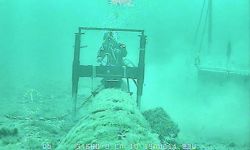Reimagined St. Ignace memorial to be a showcase of Native American history

- The DNR received a $3.6 million grant to incorporate more Native American history in a restoration project
- The project includes rebuilding the Father Marquette National Memorial with new exhibits and art work
- The DNR partnered with several Tribes on the project
An Upper Penninsula monument that burned to the ground 24 years ago is getting new life and a new historical focus thanks to multiple partners and a $3.6 million grant.
The project will expand the Father Marquette National Memorial site in St. Ignace, after the original was struck by lightning in 2000. It is being reconstructed as an educational resource that highlights the impacts and experiences of the Native American people who were already living in the area for generations when Louis Jolliet and Jacques Marquette landed in the Upper Peninsula.
“Our tribe and others have a deep connection to the Straits region, and this project will provide an important Anishinaabe perspective on how respecting the waters and the lands are an essential part of the long-term relationship we have with Aki (the earth) and with each other,” said Austin Lowes, chair of Sault Ste. Marie Tribe of Chippewa Indians.
“Our hope is that visitors will be able to incorporate this perspective into their own understanding so they see the world in a different light and make sustainable decisions in their own communities.”
Related:
- Michigan’s lost winter cancels sturgeon season, ski, dog sled races
- Turtles return, 10 years after Kalamazoo River oil spill
- Michigan deer: Hunters share thoughts on managing a changing herd
The grant, awarded by The Mellon Foundation’s Monuments Project, supports a partnership between the Department of Natural Resources’ Michigan History Center, the Sault Ste. Marie Tribe of the Chippewa Indians, the Mackinac Straits Health System and Lake Superior State University.
The original memorial, one of 18 public monuments dedicated to Jesuit missionary Jacques Marquette in the U.S., opened in 1976.
That memorial marked the French exploration of the Mississippi river led by Marquette and Jolliet. In 1666 Marquette created the first European settlement in what is now Sault Ste. Marie. Later he settled in St. Ignace. Native Americans were established in the region for many years prior to Marquette’s arrival.
“The Father Marquette story is a fascinating story but we seldom share very much about the Native American communities that he was living with and we really need to tell their story as well,” said Sandra Clark, director of the Michigan History Center.
The project, seven years in the making, includes the construction of new educational structures, exhibits and art that add Native American context and perspectives to the Father Marquette National Memorial site, she confirmed.
“We're building a learning commons and it will have some exhibit areas in it,” Clark said. “We will do some of it with signage on some of the trails where that's equally appropriate, when we're talking about how they interacted with the natural environment.”
Construction will begin this summer and if all goes well, Clark said, the site will be open by summer 2025.
The history of the Sault Ste. Marie Tribe of Chippewa Indians dates back to 3000 B.C. They named the region Gchi Mshiikenh Deh Minising, or Heart of the Great Turtle Island, according to the Michigan History Foundation. Anishinaabeg —meaning “original people”— believed the Great Lakes were the heart of North America.
Lowes said The Sault Tribe has been working on this project with the DNR for seven years. Other tribes like Bay Mills Indian Community, The Little Traverse Bay Bands of Odawa Indians and Match-E-Be-Nash-She-Wish Band of Pottawatomi Indians of Michigan (Gun Lake Tribe) were also invited to help and share their stories, the DNR confirmed.
Michigan Environment Watch
Michigan Environment Watch examines how public policy, industry, and other factors interact with the state’s trove of natural resources.
- See full coverage
- Subscribe
- Share tips and questions with Bridge environment reporter Kelly House
Michigan Environment Watch is made possible by generous financial support from:
Our generous Environment Watch underwriters encourage Bridge Michigan readers to also support civic journalism by becoming Bridge members. Please consider joining today.
See what new members are saying about why they donated to Bridge Michigan:
- “In order for this information to be accurate and unbiased it must be underwritten by its readers, not by special interests.” - Larry S.
- “Not many other media sources report on the topics Bridge does.” - Susan B.
- “Your journalism is outstanding and rare these days.” - Mark S.
If you want to ensure the future of nonpartisan, nonprofit Michigan journalism, please become a member today. You, too, will be asked why you donated and maybe we'll feature your quote next time!






